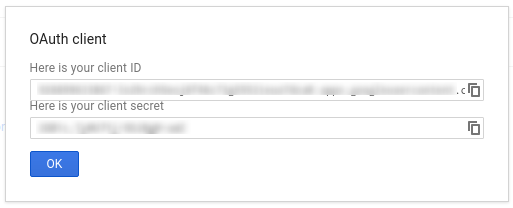所有 Google Ad Manager API 呼叫都必須透過 OAuth2 公開標準 讓使用者將權限授予第三方應用程式,因此 應用程式可代表使用者與網路服務互動。OAuth2 啟用 您的 Ad Manager API 用戶端應用程式,存取使用者的 Ad Manager 帳戶 無需處理或儲存使用者的使用者名稱和密碼
產生 OAuth2 憑證
請按照下列步驟產生 OAuth2 憑證。
1. 決定驗證類型
請參閱下表,瞭解最合適的驗證類型 Ad Manager API 應用程式:
| 選擇 OAuth2 驗證類型 | |
|---|---|
| 服務帳戶 |
如果您只需要存取自己的 Ad Manager 資料,請選擇這個選項。 瞭解詳情。 |
| 網頁應用程式 |
如要以任何授予授權的使用者身分進行驗證,請選擇這個選項 授予應用程式存取 Ad Manager 資料的權限。 瞭解詳情。 |
2. 建立 OAuth2 憑證
決定驗證類型後,按一下對應的分頁 並按照操作說明產生 OAuth2 憑證:
- 開啟 Google API 控制台「憑證」頁面。
- 從專案下拉式選單中選取 [建立新專案] 並輸入名稱。 並視需要編輯提供的專案 ID。按一下 建立。
- 在「憑證」頁面上選取「建立憑證」,然後 選取「服務帳戶金鑰」。
- 選取「New service account」(新增服務帳戶),然後選取「JSON」JSON。
- 按一下「建立」,下載內含私密金鑰的檔案。
- 開啟 Google API 控制台「憑證」頁面。
- 從專案下拉式選單中選取 [建立新專案] 並輸入名稱。 (也可視需要編輯提供的專案 ID),然後按一下 建立。
- 在「憑證」頁面上選取「建立憑證」,然後 選取「OAuth 用戶端 ID」。
- 系統可能會提示您設定產品名稱 同意畫面頁面;如果需要,請按一下「設定同意畫面」。 提供必要資訊,然後按一下 [儲存] 返回 「憑證」頁面。
- 在「應用程式類型」中選取 [網路應用程式]。跟著 瞭解如何輸入 JavaScript 來源和/或重新導向 URI。
- 按一下「建立」。
- 在隨即顯示的網頁中,複製「用戶端 ID」與「用戶端密鑰」。 到剪貼簿,因為在設定用戶端時將會需要 資源庫。

3. 設定 Ad Manager 聯播網
如果您是第三方開發人員,可能需要請客戶進行這項操作 。
- 前往您的 Ad Manager 聯播網。
- 按一下 [管理] 標籤。
- 確認已啟用 API 存取權。
- 按一下「新增服務帳戶使用者」按鈕。
- 使用服務帳戶電子郵件地址填寫表單。 服務帳戶使用者必須獲得 就好比服務帳戶使用者能存取 以及如何透過使用者介面
- 按一下「Save」按鈕。系統會顯示訊息 以及新增服務帳戶
- 如要查看現有服務帳戶使用者,請前往「使用者」分頁,然後 按一下 [Service Account] (服務帳戶) 篩選器。
- 前往您的 Ad Manager 聯播網。
- 按一下 [管理] 標籤。
- 確認已啟用 API 存取權。
4. 設定及使用用戶端程式庫
請按照下列適當指南使用用戶端程式庫中的憑證:
Java
.NET
Python
PHP
小茹
如果您選擇不使用我們的用戶端程式庫,就必須將 OAuth2 服務帳戶或網路 應用程式流程
幕後花絮
我們的用戶端程式庫會自動處理下方的細節,因此 但一定要瞭解幕後花絮。 本節適用於熟悉的進階使用者 OAuth2 規格和 瞭解如何搭配使用 OAuth2 與 Google API。
HTTP 請求標頭
傳送至 Ad Manager API 的每個請求中,HTTP 標頭都必須包含存取權 符記:
Authorization: Bearer ACCESS_TOKEN
例如:
POST … HTTP/1.1 Host: … Authorization: Bearer 1/fFAGRNJru1FTz70BzhT3Zg Content-Type: text/xml;charset=UTF-8 Content-Length: … <?xml version="1.0"?> <soap:Envelope xmlns:soap="http://www.w3.org/2001/12/soap-envelope"> … </soap:Envelope>
範圍
單一存取權杖可以授予不同程度的多個 API 存取權。A 罩杯
名為 scope 的變數參數可控制一組資源和
作業。在存取權杖要求期間,您的
應用程式會在 scope 參數中傳送一或多個值。
Ad Manager 只有一個範圍,如下所示。應執行授權 產品內使用者層級的操作
| 範圍 | 權限 |
|---|---|
https://www.googleapis.com/auth/dfp |
查看及管理您在 Ad Manager 中的廣告活動。 |

